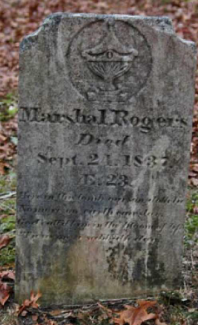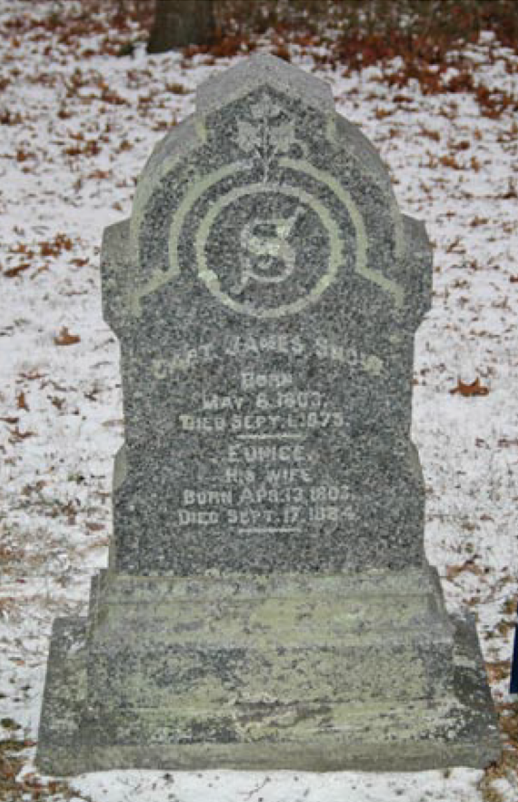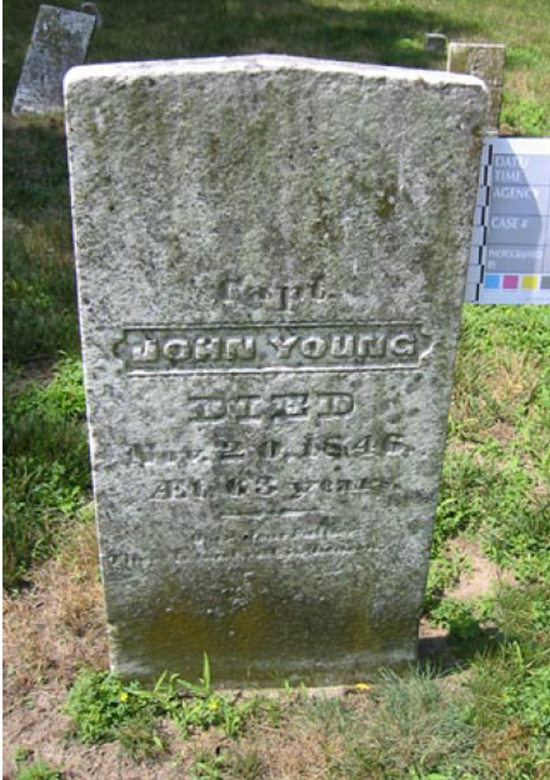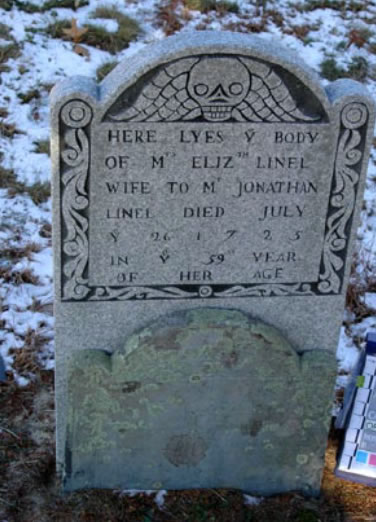Orleans has four cemeteries within its borders – the Rogers Cemetery, the Smallpox Cemetery, the Methodist Burial Grounds, and the Orleans Cemetery. To find more information about the gravesites, the websites findagrave.com and capecodgravestones.com are very useful.
Rogers Cemetery
The Rogers Cemetery is a tiny cemetery located in the woods behind private homes east of Route 39 in South Orleans between Cross Road and Woodridge Road. It contains the burial sites of five members of the Rogers family, with the earliest date of death in 1829 and the latest in 1877.

Rogers Cemetery. Marker for Marshall Rogers. Photo used with permission by the Chicora Foundation, Inc.
Smallpox Cemetery aka Meetinghouse Road Cemetery aka East Orleans Cemetery aka Eastern Cemetery
The Smallpox Cemetery is located on the easterly side of the intersection of Main Street and Meetinghouse Road. Its address is 15 Meetinghouse Road, 19 Meetinghouse Road and 166 Main Street. Data from the Massachusetts Cultural Resource Information System (MACRIS) inventory form states:
“This cemetery was established in the 1830s after the towns first cemetery, on the opposite side of the street was filled. Many of the persons buried here are children who died in the mid- 1830s as a result of a smallpox epidemic. After the epidemic, others seemed reluctant to be buried here. In 1850, five acres were added to the old cemetery and this one eventually fell into disuse.”
In the 17th and 18th centuries, smallpox’s contagiousness was well known but the exact nature of its transmission was not fully understood. Those who died from smallpox were segregated from other burials in the early years of the colonies.

Smallpox Cemetery. Marker for Captain James Snow and Eunice Snow. Photo used with permission of the Chicora Foundation, Inc.
The Methodist Burial Ground aka Old Methodist Cemetery aka Orleans Center Cemetery
The Methodist Burial Ground is at 33 Main Street, at the intersection of Main Street and Cranberry Highway (aka Route 6A). It was established in the mid-1820s when the Methodist Society set aside the land for a cemetery. At that time the cemetery was far from the center of town. It was the custom of Cape Cod towns in the 19 th century to place cemeteries on the outskirts of towns and in the early part of that century Rock Harbor was the center of activity in Orleans. The packet boats carried mail between Rock Harbor and Boston, and commerce was centered at the harbor. The passage of time, economic development, and ultimately the coming of the railroad, caused the center of activity to migrate inland and the Methodist Burial Ground is now squarely within the town center.

Methodist Cemetery. Headstone of John Young. Photo with permission of the Chicora Foundation, Inc.
Orleans Cemetery
The Orleans Cemetery is located at 144 Main Street next to the Federated Church and its area spans from Main Street to Tonset Road. It contains the remains of many families important to the early days of Orleans’ history, with names like Snow, Hopkins, Mayo, Sparrow, Paine, and Freeman. There are over 1,000 headstones here as of 2022.
The oldest part of the cemetery is the area just to the west of the Federated Church, which was originally known as the South Parish Meetinghouse. The earliest stones date to about 1723. Prior to 1723, those who lived in what is now Orleans were buried in Eastham at the Old Cove Cemetery. About 1829 the Orleans Cemetery became full, and the land across Meetinghouse Road began to be used. That cemetery is now called the Smallpox Cemetery or the Meetinghouse Road Cemetery or the East Orleans Cemetery or the Eastern Cemetery. In 1850 five acres of additional land was purchased adjacent to the original land by a citizens group, the Orleans Cemetery Association. A second purchase of nine acres in 1876 brought the total land to the current 25 acres. This cemetery is still in use.

Methodist Cemetery. Headstone of John Young. Photo with permission of the Chicora Foundation, Inc.